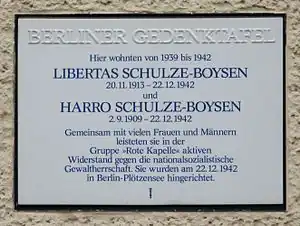
Berlin memorial plaque (German: Berliner Gedenktafel) is a special form of commemorative plaque, made by the Royal Porcelain Factory, in Berlin that was introduced in 1985 in preparation for the city's 750th anniversary in 1987. The porcelain-coloured panels have a rectangular shape measuring 60 by 40 centimetres (24 in × 16 in) and bear the title "Berlin Memorial Plaque" in capital letters and a cobalt blue explanatory inscription on a white background. The factory logo is present at the base of the panel, in the form of a cobalt blue sceptre. The design was determined in a competition that was won by the graphic artist Wieland Schütz.[1]
History
As early as the 19th century, the Berlin Magistrate began to erect commemorative plaques and commemorative signs for people and events in the public spaces. For example, for the year 1930, the list includes 59 commemorative plaques in the inner district alone and a further 47 copies in all other districts of Berlin were hung.[2] In the 20th century, uniform representations were sought and the Berlin plaque was developed.
Chronology
1985–1991
Originally, the design of the plaque cost 1200 Deutsche Marks. According to the plans at the time, each district of West Berlin would receive about 25 plaques, sponsored by the Sparkasse of Berlin.[3]
The first three plaques were placed on 22 October 1985.[4]
1992–2000
After the Peaceful Revolution the memorial plaque program was extended to the East Berlin, with the Sparkasse again paying the costs of the program. A total of 350 panels, now worth 3,000 marks per table, were planned by the year 2000.[5] The technical supervision of the new project was taken over by the Historical Commission of Berlin.
By the turn of the century, the funds provided by the Sparkasse had been exhausted.[6]
From 2000
After the turn of the century, it was decided that an applicant must make a payment of 2500 Euro's, gain permission from the owner of the property where the plaque is to be placed and gain permission from the district council (German: Kreistag) before proceeding with the placement of the plaque. Once that is completed, the Historical Commission of Berlin will drawn up an agreement with the applicant, to ensure it appropriate. Wieland Schütz then provides the graphic implementation of the text, partly with further design features. The final pressure on the board is done by the KPM. Finally, the applicant ensures that the plaque is affixed correctly, which will then become the property of the respective district office.[7]
Gallery
Examples of some Berlin memorial plaques:
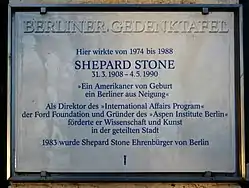 Berlin memorial plaque for Shepard Stone.
Berlin memorial plaque for Shepard Stone.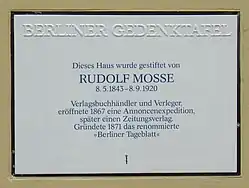 Berlin memorial plaque for Rudolf Mosse at the Mosse pen.
Berlin memorial plaque for Rudolf Mosse at the Mosse pen.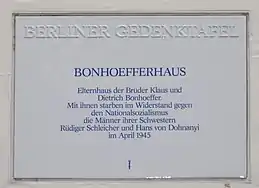 Berlin memorial plaque at Bonhoeffer house.
Berlin memorial plaque at Bonhoeffer house.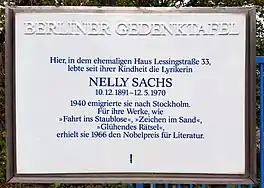 The site of Nelly Sachs' former house in Lessingstraße.
The site of Nelly Sachs' former house in Lessingstraße.
Literature
- Döhrer, Constanze; Hobrack, Volker; Keune, Angelika (2012). Spuren der Geschichte : neue Gedenktafeln in Berlins Mitte (in German). Berlin: Berlin Story Verlag. ISBN 978-3-929829-44-0.
- Baudisch, Rosemarie; Ribbe, Wolfgang (2014). Gedenken auf Porzellan : eine Stadt erinnert sich (in German). Berlin: Nicolai. ISBN 978-3-89479-843-7.
References
- ↑ "Erinnerungen in Porzellan" [Memories in porcelain]. Verlag Der Tagesspiegel GmbH. Der Tagesspiegel. 6 June 2007. Retrieved 23 May 2020.
- ↑ "Gedenktafeln und Erinnerungszeichen" [Commemorative plaques and commemorative signs]. Berlin Central and Regional Library (ZLB) (in German). Berlin: Berliner Adreßbuch. 1930. p. 221. Retrieved 23 May 2020.
- ↑ Schütze, Elmar (15 February 1997). "Forum will Tafeln an mehreren Wohnhäusern in der Havelstadt anbringen / Weitere Vorschläge erbeten: Mahnmale zum Gedenken an jüdische Geschichte" [Forum wants to put up plaques at several residential buildings in the Havelstadt / Further suggestions requested: Memorials to commemorate Jewish history] (in German). Berliner Verlag. Berliner Zeitung. Retrieved 23 May 2020.
- ↑ Hübner, Holger (13 May 2012). "©beimAutorundbeiderGedenkstätteDeutscherWiderstand2012Holger Hübner Das Gedächtnis der Stadt. Gedenktafeln in Berlin" [The Memory of the City. Commemorative plaques in Berlin (foreword to the 1997 book edition)] (PDF). Gedenkstätte Deutscher Widerstand (in German). Berlin. Archived from the original (PDF) on 21 February 2016. Retrieved 23 May 2020.
- ↑ Körting, Katharina (12 April 2000). "Glienicker Brücke: CDU setzt ihren Gedenktafeltext durch: Kein Wort über den Austausch von Agenten" [Glienicker Bridge: CDU enforces its commemorative plaque text: No word on the exchange of agents] (in German). Berliner Verlag. Berliner Zeitung. Retrieved 23 May 2020.
- ↑ Thiemen, Monika (24 August 2002). "Zur Enthüllung einer Gedenktafel für Rudolf Breitscheid an seinem 58. Todestag an seinem früheren Wohnhaus Fasanenstr. 58, 10719 Berlin" [Speech by the mayor Monika Thiemen on 24 August 2002, On the unveiling of a plaque commemorating Rudolf Breitscheid on the 58th anniversary of his death at his former residence Fasanenstr. 58, 10719 Berlin]. Berlin (in German). Berlin: Anbieterkennzeichnung des Betreibers. Retrieved 23 May 2020.
- ↑ "Minutes of the Committee" (PDF). Bundestag (in German). Berlin: Committee on Cultural Affairs. 10 May 2005. Retrieved 23 May 2020.
External links
- Official website – Official site